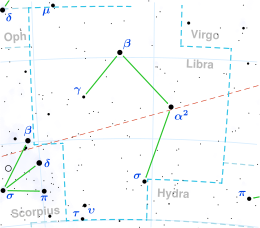Sigma Librae
| Observation data Epoch J2000.0 Equinox J2000.0 (ICRS) |
|
|---|---|
| Constellation | Libra |
| Right ascension | 15h 04m 04.21608s |
| Declination | –25° 16′ 55.0606″ |
| Apparent magnitude (V) | 3.20 - 3.46 |
| Characteristics | |
| Spectral type | M3/M4 III |
| U−B color index | +1.94 |
| B−V color index | +1.70 |
| Variable type | SRb |
| Astrometry | |
| Radial velocity (Rv) | –4.2 km/s |
| Proper motion (μ) |
RA: –71.16 mas/yr Dec.: −43.34 mas/yr |
| Parallax (π) | 11.31 ± 0.25mas |
| Distance | 288 ± 6 ly (88 ± 2 pc) |
| Absolute magnitude (MV) | –1.5 |
| Details | |
| Mass | 2.1 M☉ |
| Surface gravity (log g) | 0.9 ± 0.3 cgs |
| Temperature | 3,600 K |
| Metallicity [Fe/H] | 0.00 dex |
| Other designations | |
| Database references | |
| SIMBAD | data |
Sigma Librae (σ Lib, σ Librae) is a star in the constellation Libra. The apparent visual magnitude is +3.29, making it a third magnitude star that is visible to the naked eye. Based upon parallax measurements, this star is at a distance of roughly 288 light-years (88 parsecs) from Earth, with a 2% margin of error. At that distance, the visual magnitude of the star is diminished by 0.20 ± 0.17 from extinction caused by intervening gas and dust.
The star was originally given the Bayer designation "Gamma Scorpii" (γ Sco). It did not receive its current Bayer designation as Sigma Librae until the 19th century. The new name was agreed upon by Commission 3 of the International Astronomical Union on July 31, 1930.
It has the Latin names Brachium "arm" and Cornu "horn", and the non-unique minor Arabic names Zuben el Genubi "southern claw" (which it shares with Alpha Librae), Zuben Hakrabi (which it shares with Gamma Librae and Eta Librae (the latter also rendered Zuban Alakrab), and Ankaa (which it shares with Alpha Phoenicis).
Sigma Librae has a spectral class M3/M4 III, which places it in the red giant stage of its evolution. This is a semi-regular variable star with a single pulsation period of 20 days. It shows small amplitude variations in magnitude of 0.10–0.15 on time scales as brief as 15–20 minutes, with cycles of repetition over intervals of 2.5–3.0 hours. This form of variability indicates that the star is on the asymptotic giant branch and is generating energy through the nuclear fusion of hydrogen and helium along concentric shells surrounding an inert core of carbon and oxygen.
...
Wikipedia

